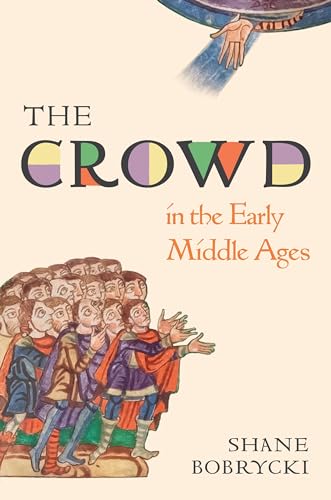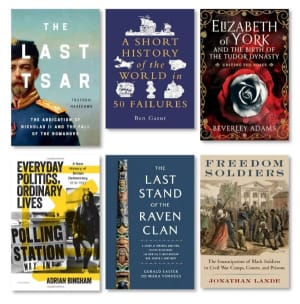The Crowd in the Early Middle Ages
Shane Bobrycki, assistant professor of medieval history at the University of Vienna1, has written an excellent short (177 page) book about early medieval Europe, looking at how and why people gathered, and how that compares to gatherings in the Classical Roman world and later medieval Europe.
Look on my Works, ye Mighty, and despair!
By 650, the ruins of the Colosseum, built in the first century to accommodate an audience of fifty thousand in a city of one million, could have held Rome’s population twice over.
Shane Bobrycki, The Crowd in the Early Middle Ages
I recently spent a couple of days in Rome. I was lucky enough to stay in an apartment on a street which overlooked the imperial forums. Specifically, after quite a bit of digging, I discovered that the columns I could see at the end of the street once belonged to the Temple of Mars Ultor in the Forum of Augustus. History buff Maddox von Ranke recommended that I visit Trajan’s Markets (forming part of the imperial forums) which I duly did.
I particularly enjoyed the illustrations of the various imperial forums comparing them at their imperial peak, and in medieval abandon; once bustling engines of bureaucracy, law, politics, and commerce had been taken over by peasant huts, small-holdings, and trees. It fed a satisfyingly old fashioned Gibbonian sense of civilizational decline.
The reality was, of course, a bit more complex – people still lived in Rome, but moved closer to the river after the Ostrogoths cut the aqueducts. But the population of Rome did decline significantly, as vividly illustrated by the above quote from the book.
Are you not entertained?
If we think of ancient Rome, we think of crowds – the Colosseum, and the thousands of spectators who once roared their appreciation of bloodthirsty entertainment, is probably the one image above all others that comes to mind.
Were those crowds a product of numbers alone, or did the idea of the crowd live on in early medieval Europe? What becomes apparent from this book, is that it is a story of, as the author puts it in his conclusion, how ”demographic change interacts with cultural continuities”.
Having read a few books on early medieval Europe, that dichotomy between change in the tangible (whether that is in demographics, economics, or built environments) and continuity in the world of ideas, is a theme that recurs time and again. It is the conflict between those historians who emphasise change (often drawing on archaeology) and those drawing on continuity (who often emphasise written sources).
For me, the best historians of this period, like Chris Wickham, manage to reconcile and convey the sense of both, and draw evidence from all available sources. In my opinion, Shane Bobrtcki manages to do that too and by doing so, his book becomes a lens not only to understand the role of the crowd in early medieval Europe, but to understand this period as a whole, and those which preceded and followed it.
Crowds or gatherings?
This book uses the term ‘crowd’ in the broadest possible sense. In fact, it could have more accurately been called ‘gatherings’, but that does not provide for a particularly appealing title page.
The author considers all sorts of crowds (or gatherings) – we meet the mass entertainment crowds of ancient civilisation – games, circuses, theatres (which largely disappeared in the early Middle Ages in the remnants of the Western empire, whilst living on in the Byzantine Empire).
The author considers the role of riots and revolts and how that changed with population and urban decline (they became much less common). But crowds could also occur in religious contexts (church services, councils of religious leaders, witnesses to miracles and saint lives).
People also came together for military, economic and political reasons: the war-band, the hunt, the harvest, and the political assembly. And crowds could be abstract as well as physical – cliches of ‘numberless’ crowds and ‘multitudes’ as religious witnesses, or as members of a Christian community – the author notes that by the 900s, the confraternity book at Reichenau2 contained 38,232 names, more than inhabited contemporary Rome.
Crowds – reality, language and representation
The book also considers crowds from every possible perspective:
- the historiography of crowd history in this period,
- the contribution of ideas from psychology and sociology
- the ancient Roman context
- the evidence for demographic and physical change (cities in what was the Western Roman Empire became much smaller)
- the evidence from linguistics; and
- the representation of crowds in literature.
Because of my own personal interests and preferences, I found some of these chapters more interesting that others; I tend to enjoy the ‘tangible’ stuff (demographics, evidence of actual gatherings and events) more than the sections on the changing meaning of words and representations – some of the literary/linguistic analysis (topoi, type scenes, etc.) is a little slow going. But the author manages to draw links between these different perspectives in a way that I found thought-provoking, and convincing.
The decline and fall of the urban riot
It is in examining the interaction between the nature of crowds (their type, size and frequency) and attitudes towards them that the book is most insightful.
Classical Roman elites often found crowds threatening, but their attitudes were nuanced. In a world of large urban agglomerations, non-elite gatherings could more easily be a vehicle for popular expression – as such they were feared, but also, to an extent, respected.
One of the sharpest contrasts of the early medieval West with the periods preceding and following it, was the scarcity of accounts of popular revolt or riot. The number of documented riots or uprisings are rare, to the extent that they can all be covered off over a few pages in the book. The author is reasonably convinced that this reflects a world in which it was more difficult for the urban or rural poor to express their dissatisfaction by direct group action (rather than, for example, simply reflecting a disinclination to report such events by contemporary chroniclers).
As a result, attitudes towards crowds were less inherently negative in Europe in the Middle Ages. Rather than being a threat, crowds were often perceived as inherently legitimising, particularly in the context of witness crowds to religious events, persons or objects.
Same words, different meanings
That change in perceptions is convincingly tracked by the author onto the changing meaning of words. The same words (such as populus, contio, and turba) continued to be used both before and after the fall of the Western Roman Empire, but evolved and took on different connotations, usually less inherently negative.
The threatening and negative crowd continued to live on in early medieval literature, but more often had to be conveyed by the addition of other characteristics which delegitimised that crowd, such as foreignness, femininity, or rusticity.
The crowd as a scarce resource
In a period in which the crowd became, in the words of the author, a ‘scarce resource’, a more common means for people to express their dissatisfaction through group action came in the form of ‘slantwise resistance’: gatherings in the wrong place, at the wrong time, or in the wrong way, or refusal to gather when asked to do so by those in power.
Most commonly, such unauthorised gatherings were condemned by elites as superstition, such as crowds drawn to preachers or relics not sanctioned by the Church. What they demonstrate is the continued ability of the poor, whether urban or rural, to resist elite control, even in a world where a Classical Roman style ‘riot’ became a logistical challenge or impossibility.
What did I think of the book?
On its face, the subject matter of this book might feel a little esoteric. In fact, I found it a fascinating window into an often-misunderstood period of Western European history. The author has clearly mastered his subject matter and conveys that knowledge clearly and authoritatively.
Furthermore, the author convincingly uses the idea of the crowd in early medieval Europe as a way of drawing insightful comparisons with the Classical Roman West and the later medieval Europe.
Was there anything I didn’t like about the book?
The book's focus is on the post-imperial successor states in what was the Roman Western Empire, whilst occasionally drawing comparisons with those parts of the empire which either continued (the Byzantine) or formed part of the new Islamic world. In the latter, larger cities and the attitudes which accompanied those persisted longer.
One criticism which could be made of the book is that the author never explicitly sets out the intended geographic scope of the book from the start, although I can’t say that impacted in any meaningful way on my enjoyment of the book – from the examples he gives, it’s relatively easy to understand what the author is trying to convey and where and when his analysis applied to.
At times, I wondered whether the use of more complex terminology was necessary (’synchronic and diachronic comparison’ is used a lot) but, overall, I never found the book impenetrable, and I am a non-academic, so the book should be accessible to a public readership with some interest in the subject-matter.
Conclusion
At only 177 pages (excluding notes) this book is small in size but big in ideas. If you have an interest in Europe in the Early Middle Ages, you’ll find this an excellent way of enriching your knowledge of this period of history. The book will also get you thinking about broader questions about how people gather, and when, where and why they might do so.
An internet search appears to throw up lots of other job descriptions for the author as well, including ‘assistant professor in the Department of History at the University of Iowa’ and ‘postdoctoral Prize Fellow in Economics, History, and Politics at Harvard University and the Massachusetts Institute of Technology’. ↩︎
Editor’s footnote: Wikipedia informs me that Reichenau Abbey was a Benedictine monastery on Reichenau Island in southern Germany just on the border with Switzerland. ↩︎
Book details
(back to top)- Title -
The Crowd in the Early Middle Ages
- Author -
Shane Bobrycki
- Publication date -
November 2024
- Publisher -
Princeton University Press
- Pages -
336
- ISBN 13 -
9780691189697
- Amazon UK -
- Amazon US -



